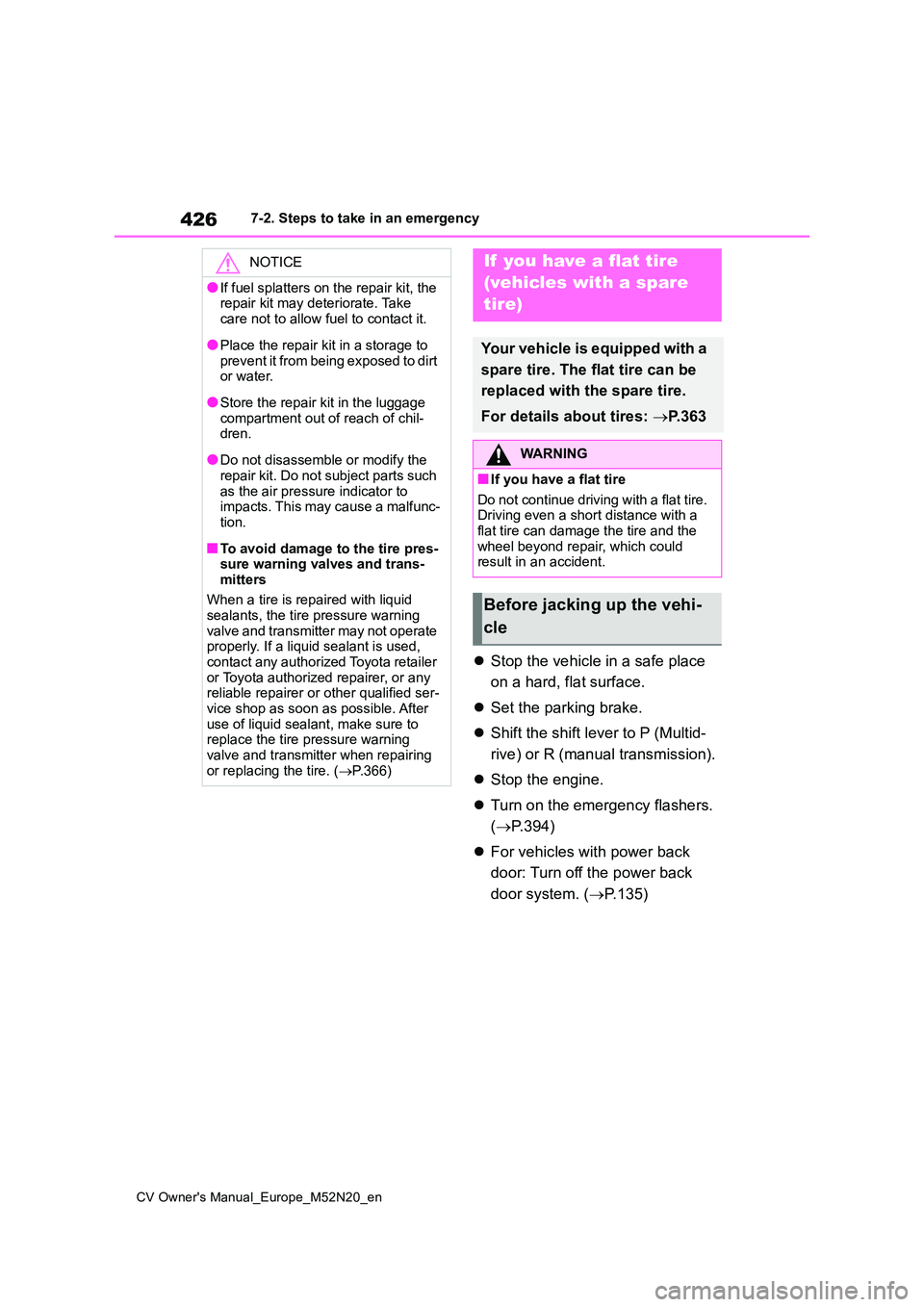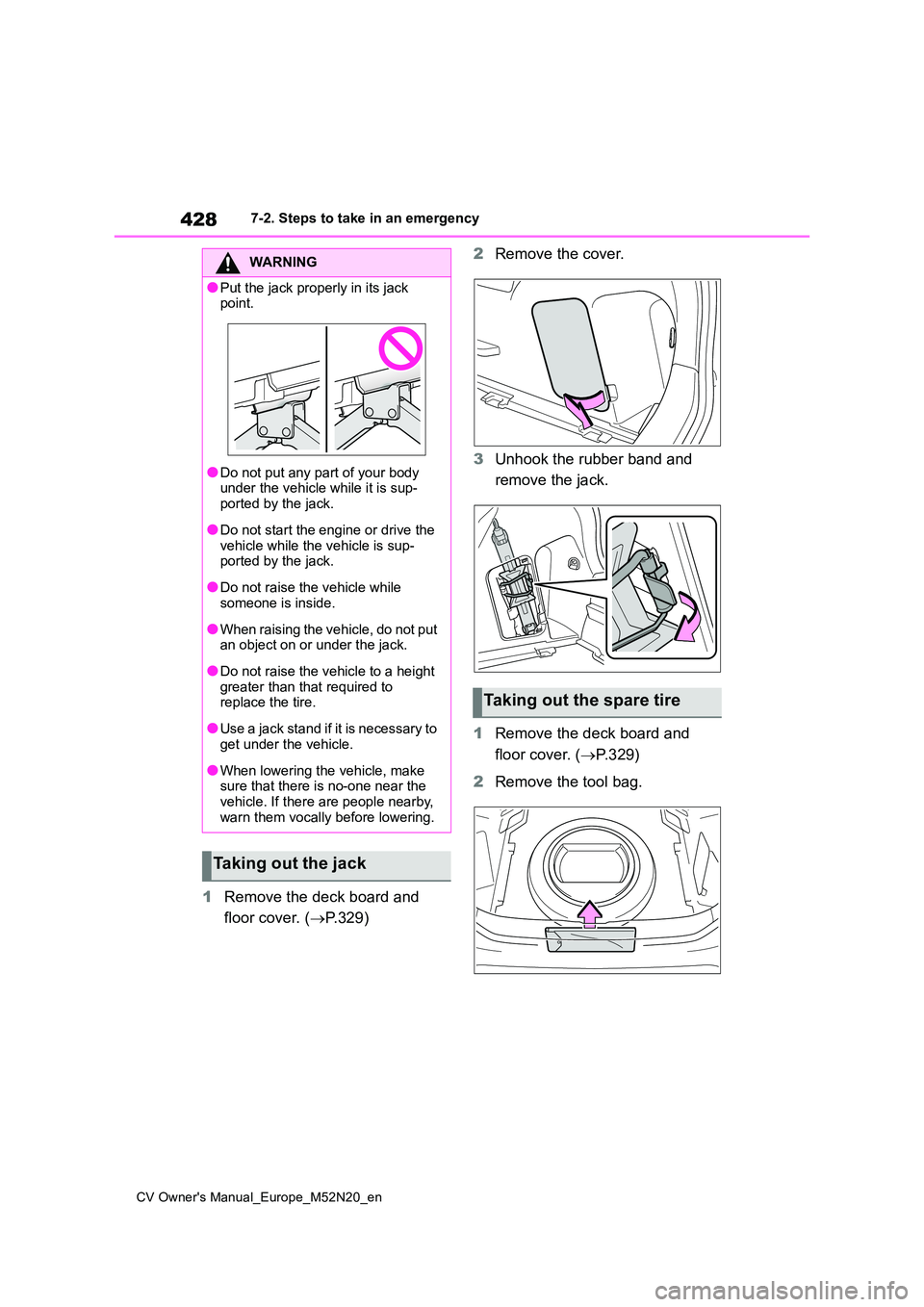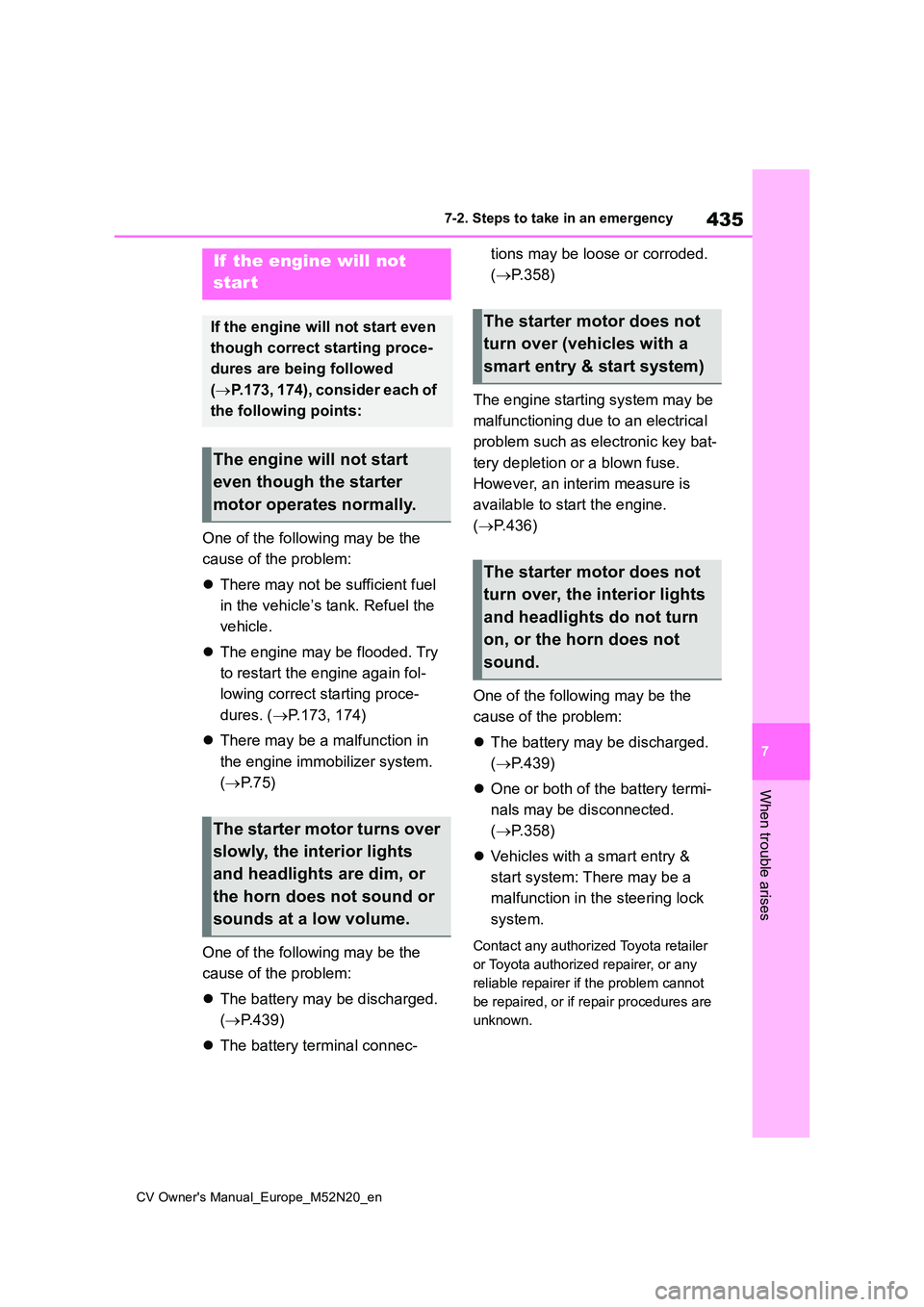2022 TOYOTA YARIS CROSS engine
[x] Cancel search: enginePage 418 of 618

416
CV Owner's Manual_Europe_M52N20_en
7-2. Steps to take in an emergency
Stop the vehicle in a safe place
on a hard, flat surface.
Set the parking brake.
Shift the shift lever to P (Multid-
rive) or N (manual transmission).
Stop the engine.
Turn on the emergency flashers.
( P.394)
For vehicles with power back
door: Turn off the power back
door system. ( P. 1 3 5 )
Check the degree of the tire
damage.
Do not remove the nail or screw
from the tire. Removing the object
may widen the opening and make
emergency repair with the repair kit
impossible.
• A tire should only be repaired
with the emergency tire puncture
repair kit if the damage is caused
by a nail or screw passing
through the tire tread.
• To avoid sealant leakage, move
the vehicle until the area of the
puncture, if known, is positioned
at the top of the tire.
■A flat tire that cannot be repaired with the emergency tire puncture
repair kit
In the following cases, the tire cannot be repaired with the emergency tire punc-
ture repair kit. Contact any authorized Toyota retailer or Toyota authorized repairer, or any reliable repairer.
●When the tire is damaged due to driv-ing without sufficient air pressure
●Wh e n t he r e a r e an y cr a ck s or da ma g e at any location on the tire, such as on
the side wall, except the tread
●When the tire is visibly separated from
the wheel
●When the cut or damage to the tread
is 4 mm (0.16 in.) long or more
●When the wheel is damaged
●When two or more tires have been punctured
●When more than 2 sharp objects such as nails or screws have passed
through the tread on a single tire
●When the sealant has expired
WARNING
■If you have a flat tire
Do not continue driving with a flat tire.
Driving even a short distance with a flat tire can damage the tire and the wheel beyond repair, which could
result in an accident.
Before repairing the tire
Page 423 of 618

421
7
CV Owner's Manual_Europe_M52N20_en
7-2. Steps to take in an emergency
When trouble arises
10Connect the power plug to the
power outlet socket. ( P.333)
11 Check the specified tire inflation
pressure.
Tire inflation pressure is specified on the label on the driver’s side door frame as shown. ( P.454)
Left-hand drive vehicles
Right-hand drive vehicles
12 Start the vehicle’s engine.
13 To inject the sealant and inflate
the tire, turn the compressor
switch to (on).
14 Inflate the tire until the specified
air pressure is reached.
The sealant will be injected and
the pressure will surge and then
gradually decrease.
The air pressure gauge will dis-
play the actual tire inflation pres-
sure about 1 minute (5 minutes
Page 428 of 618

426
CV Owner's Manual_Europe_M52N20_en
7-2. Steps to take in an emergency
Stop the vehicle in a safe place
on a hard, flat surface.
Set the parking brake.
Shift the shift lever to P (Multid-
rive) or R (manual transmission).
Stop the engine.
Turn on the emergency flashers.
( P.394)
For vehicles with power back
door: Turn off the power back
door system. ( P.135)
NOTICE
●If fuel splatters on the repair kit, the repair kit may deteriorate. Take
care not to allow fuel to contact it.
●Place the repair kit in a storage to
prevent it from being exposed to dirt or water.
●Store the repair kit in the luggage compartment out of reach of chil-dren.
●Do not disassemble or modify the repair kit. Do not subject parts such
as the air pressure indicator to impacts. This may cause a malfunc-tion.
■To avoid damage to the tire pres-sure warning valves and trans-
mitters
When a tire is repaired with liquid sealants, the tire pressure warning
valve and transmitter may not operate properly. If a liquid sealant is used, contact any authorized Toyota retailer
or Toyota authorized repairer, or any reliable repairer or other qualified ser-vice shop as soon as possible. After
use of liquid sealant, make sure to replace the tire pressure warning valve and transmitter when repairing
or replacing the tire. ( P.366)
If you have a flat tire
(vehicles with a spare
tire)
Your vehicle is equipped with a
spare tire. The flat tire can be
replaced with the spare tire.
For details about tires: P. 3 6 3
WARNING
■If you have a flat tire
Do not continue driving with a flat tire. Driving even a short distance with a flat tire can damage the tire and the
wheel beyond repair, which could result in an accident.
Before jacking up the vehi-
cle
Page 430 of 618

428
CV Owner's Manual_Europe_M52N20_en
7-2. Steps to take in an emergency
1Remove the deck board and
floor cover. ( P.329)
2 Remove the cover.
3 Unhook the rubber band and
remove the jack.
1 Remove the deck board and
floor cover. ( P.329)
2 Remove the tool bag.
WARNING
●Put the jack properly in its jack point.
●Do not put any part of your body under the vehicle while it is sup-
ported by the jack.
●Do not start the engine or drive the
vehicle while the vehicle is sup- ported by the jack.
●Do not raise the vehicle while someone is inside.
●When raising the vehicle, do not put an object on or under the jack.
●Do not raise the vehicle to a height greater than that required to replace the tire.
●Use a jack stand if it is necessary to get under the vehicle.
●When lowering the vehicle, make sure that there is no-one near the
vehicle. If there are people nearby, warn them vocally before lowering.
Taking out the jack
Taking out the spare tire
Page 435 of 618

433
7
CV Owner's Manual_Europe_M52N20_en
7-2. Steps to take in an emergency
When trouble arises
system. Also, if you replace the compact
spare tire after the tire pressure warning light comes on, the light remains on.
■If you have a flat rear tire (vehicles
with a compact spare tire in some
countries*)
Do not install the compact spare tire to rear axles.
Install the compact spare tire on one of the front wheels of the vehicle.
1 Replace a front tire with the compact spare tire.
2 Replace the flat rear tire with the tire
removed from the front of the vehi- cle.*: Guadelope, Martinique, F. Guiana,
Ceuta & Melilla, Ukraine, Turkey, New
Caledonia, Tahiti, Egypt
■If you have a flat front tire on a road covered with snow or ice (vehicles
with a compact spare tire)
Install the compact spare tire on one of the rear wheels of the vehicle. Perform
the following steps and fit tire chains to the front tires:
1 Replace a rear tire with the compact spare tire.
2 Replace the flat front tire with the tire
removed from the rear of the vehicle.
3 Fit tire chains to the front tires.
■When reinstalling the wheel orna- ment (steel wheels except compact spare tire)
Align the cutout of the wheel ornament with the valve stem as shown in the illustration.
WARNING
■When using the full-size spare tire (if equipped)
●Replace the full-size spare tire with a standard tire as soon as possible.
●Avoid sudden acceleration, abrupt steering, sudden braking and shift-ing operations that cause sudden
engine braking.
■When using the compact spare
tire (if equipped)
●Remember that the compact spare tire provided is specifically
designed for use with your vehicle. Do not use your compact spare tire on another vehicle.
●Do not use more than one compact spare tires simultaneously.
●Replace the compact spare tire with a standard tire as soon as possible.
●Avoid sudden acceleration, abrupt steering, sudden braking and shift-
ing operations that cause sudden engine braking.
■When the compact spare tire (if equipped) is attached
The vehicle speed may not be cor-
rectly detected, and the following sys- tems may not operate correctly:
• ABS & Brake assist
• VSC
•TRC
• Automatic High Beam (if equipped)
• Dynamic radar cruise control with
full-speed range (if equipped)
• Dynamic radar cruise control (if
equipped)
• EPS
• Trailer Sway Control (if equipped)
Page 437 of 618

435
7
CV Owner's Manual_Europe_M52N20_en
7-2. Steps to take in an emergency
When trouble arises
One of the following may be the
cause of the problem:
There may not be sufficient fuel
in the vehicle’s tank. Refuel the
vehicle.
The engine may be flooded. Try
to restart the engine again fol-
lowing correct starting proce-
dures. ( P.173, 174)
There may be a malfunction in
the engine immobilizer system.
( P. 7 5 )
One of the following may be the
cause of the problem:
The battery may be discharged.
( P.439)
The battery terminal connec-
tions may be loose or corroded.
( P.358)
The engine starting system may be
malfunctioning due to an electrical
problem such as electronic key bat-
tery depletion or a blown fuse.
However, an interim measure is
available to start the engine.
( P.436)
One of the following may be the
cause of the problem:
The battery may be discharged.
( P.439)
One or both of the battery termi-
nals may be disconnected.
( P.358)
Vehicles with a smart entry &
start system: There may be a
malfunction in the steering lock
system.
Contact any authorized Toyota retailer
or Toyota authorized repairer, or any
reliable repairer if the problem cannot
be repaired, or if repair procedures are
unknown.
If the engine will not
start
If the engine will not start even
though correct starting proce-
dures are being followed
( P.173, 174), consider each of
the following points:
The engine will not start
even though the starter
motor operates normally.
The starter motor turns over
slowly, the interior lights
and headlights are dim, or
the horn does not sound or
sounds at a low volume.
The starter motor does not
turn over (vehicles with a
smart entry & start system)
The starter motor does not
turn over, the interior lights
and headlights do not turn
on, or the horn does not
sound.
Page 438 of 618

436
CV Owner's Manual_Europe_M52N20_en
7-2. Steps to take in an emergency
When the engine does not start, the
following steps can be used as an
interim measure to start the engine
if the engine switch is functioning
normally.
Do not use this starting procedure
except in case of emergency.
1 Pull the parking brake switch to
check that the parking brake is
set. ( P.186)
Parking brake indicator will come on.
2Check that the shift lever is in P
(Multidrive) or N (manual trans-
mission).
3 Turn the engine switch to ACC.
4 Press and hold the engine
switch for about 15 seconds
while depressing the brake
pedal (Multidrive) or clutch
pedal (manual transmission)
firmly.
Even if the engine can be started using
the above steps, the system may be
malfunctioning. Have the vehicle
inspected by any authorized Toyota
retailer or Toyota authorized repairer, or
any reliable repairer.
Emergency start function
(vehicles with a smart entry
& start system)
If you lose your keys
New genuine keys can be
made by any authorized Toyota
retailer or Toyota authorized
repairer, or any reliable
repairer using the other key
(vehicles without a smart entry
& start system) or mechanical
key (vehicles with a smart
entry & start system) and the
key number stamped on your
key number plate.
Keep the plate in a safe place
such as your wallet, not in the
vehicle.
NOTICE
■When an electronic key is lost
(vehicles with a smart entry & start system)
If the electronic key remains lost, the
risk of vehicle theft increases signifi- cantly. Visit any authorized Toyota retailer or Toyota authorized repairer,
or any reliable repairer immediately with all remaining electronic keys that were provided with your vehicle.
Page 439 of 618

437
7
CV Owner's Manual_Europe_M52N20_en
7-2. Steps to take in an emergency
When trouble arises
■When the electronic key does not work properly
●Make sure that the smart entry & start system has not been deactivated in
the customization setting. If it is off, turn the function on. (Customizable features: P.457)
●Check if battery-saving mode is set. If it is set, cancel the function. ( P.137)
Use the mechanical key (P. 1 1 7 )
in order to perform the following
operations:
1 Locks all the doors
2 Unlocks all the doors
■Key linked functions
1 Closes the windows (turn and hold)*
2Opens the windows (turn and hold)*
*: These settings must be customized at
any authorized Toyota retailer or
Toyota authorized repairer, or any reli-
able repairer.
If the electronic key
does not operate prop-
erly (vehicles with a
smart entr y & start sys-
tem)
If communication between the
electronic key and vehicle is
interrupted ( P.138) or the
electronic key cannot be used
because the battery is
depleted, the smart entry &
start system and wireless
remote control cannot be used.
In such cases, the doors can
be opened and the engine can
be started by following the pro-
cedure below.
NOTICE
■In case of a smart entry & start system malfunction or other key-related problems
Take your vehicle with all the elec- tronic keys provided with your vehicle to any authorized Toyota retailer or
Toyota authorized repairer, or any reli- able repairer.
Locking and unlocking the
doors